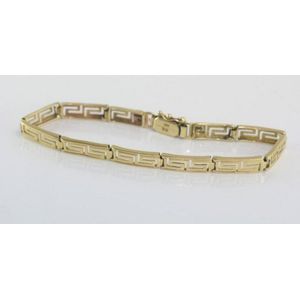Emerald and Diamond Line Bracelet
You must be a subscriber, and be logged in to view price and dealer details.
Subscribe Now to view actual auction price for this item
When you subscribe, you have the option of setting the currency in which to display prices to $Au, $US, $NZ or Stg.
- Rose Cut - A flat based cut for a preious stone, leaving the surface covered with triangular facets, usually 24 in total.
It was introduced in the 15th century and popular during the 16th and 17th centuries.
The rose cut was the most popular form of diamond cut until the discovery of the brilliant cut at the end of the 17th century, after which its use declined. - Emeralds - Emeralds have been used in jewellery making for thousands of years, and are prized for their deep green colour, which is caused by the presence of chromium and vanadium in the mineral beryl. Because of their rare colour, emeralds are often more valuable than diamonds of a similar size and quality. In jewellery making, emeralds are typically cut into round or oval shapes to maximize their color and clarity. They are often set in gold or platinum and used as the centrepiece of a piece of jewellery, such as a ring or necklace. They can also be used in combination with other gems, such as diamonds, to create intricate and beautiful designs.
- Cabochon Cut in Jewellery - A cabochon cut is a type of gemstone cutting where the stone is cut and polished in a convex shape with a flat bottom and a domed top, with no facets. This type of cut is typically used for opaque or translucent stones that have natural patterns or inclusions that are best displayed in this type of cut. Examples of stones that are often cut as cabochons include turquoise, opal, and moonstone.
This item has been included into following indexes:
Visually similar items

An emerald and diamond set line bracelet, 18ct white gold, made as a simple alternating line bracelet, set throughout with twenty oval cut emeralds of medium bright green colour, totalling approximately 17.00cts, each claw set in four bead claws, spaced by

A ruby and diamond line bracelet. 18ct white gold, made as a single four claw setting with alternating arrangements of double round rubies and single brilliant cut diamonds of matched size, fourteen diamonds totalling 4.02ct, twenty-eight rubies totalling

14ct yellow gold Greek key pattern bracelet, weight 10.48 grams, size 20 cm length

Ultima Edizione sliver and red stone bracelet (red stones test as ruby)
